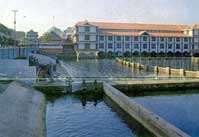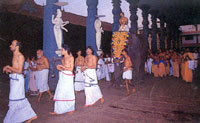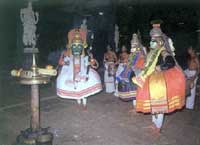|
Guruvayur also known as the Dwaraka of the South is the one of the most
popular Hindu pilgrimage spots in Kerala, attracting thousands of pilgrims
from all parts of the country. It is situated 33km North of Thrissur,
around 100km from Ernakulam.
The main attraction here is the Sree Krishna temple known as 'Guruvayoor
Ambalam' one of the greatest Krishna shrines in India. The structure of
this historic temple is typically Kerala style with gopurams (gateways),
repeated mandapas, sreekovil, subsidiary shrines around a courtyard circumbulatory.
The idol of the Sri Krishna Temple is said to have been
worshipped by Lord Brahma himself at Dwaraka and gifted to
Vishnu in his Krishnavataram. After Lord Krishna left this
earth for his heavenly abode, and the holy city of Dwaraka was to be submerged,
'Guru', the preceptor of the Devas and 'Vayu', Lord of the winds were
entrusted with the job of finding an equally holy spot for the idol. At
the end of a long quest for an appropriate site they entered Kerala and
met Parasurama, legendary creator of Kerala.
He led them to a beautiful lake full of lotuses, the present
temple tank, 'Rudratirtha', beside which Shiva and Parvati waited to welcome
them. The idol was duly installed at this spot and lovingly called Guruvauurappan,
or the Lord of Guruvayur. Since the installation was done by Guru and
Vayu the place was named as Guruvayurappa and later on as Guruvayur. Shiva
and Parvathi installed themselves in Mammiyur temple at the opposite bank
of the lake. Guruvayur temple is linked with Melpattur Narayana Bhattathiri,
the author of 'Narayaneeyam' (16th century) a Sanskrit work comprising
1000 slokas (couplets) of inimitable beauty which is believed to have
been composed in front of the deity here.
Precious materials are everywhere, as in a golden flagstaff
and flimsy replicas of the arms, legs, ears and other affected parts of
worshippers that are given as offerings. The temple faces east with two
gopurams (gateways) one on the east and the other in the west. The Eastern
'gopuram' (Kizhakkenada) of the Sri Krishna temple, also known as Bhooloka
Vaikuntam, is the main entrance to the shrine. In the centre of the inner
courtyard stands a pillared hall known as the 'Nalambalam' or 'Chutambalam'
with scores of oil lambs fixed on its walls. Inside the Chutambalam or
outer enclosure is the square two-storeyed Sreekovil (main shrine) with
three rooms, the innermost of which is the sacred sanctum sanctorum housing
the main deity and can be viewed from the temple entrance.
 This
idol of Vishnu, with four arms carrying the conch, the discus, the mace
and the lotus, and adorned with a thulasi garland and pearl necklaces,
is made of a particular stone called 'patala anjanam'. The walls of the
main shrine are filled with beautiful 17th century paintings depicting
the stories from the life of Krishna and the roof and the two doors inside
are covered by gold. In the eastern side in front of the Chutambalam stands
the tall 33.5 mt high gold plated Dwajasthambam (flag post) and adjacent
to it is a 7mt high Dipastambham (pillar of lamps) whose thirteen circular
receptacles provide a truly gorgeous spectacle when lit. The western gopuram
(Padinjarenada) is flanked by two dipastambhams. There are also shrines
to
Durga (Edathidettukkaavu Bhagawati) in the north,
Ganapathi and
Lord Ayyappan on the south side of Chutambalam here. Only
Hindus are allowed inside the temple. This
idol of Vishnu, with four arms carrying the conch, the discus, the mace
and the lotus, and adorned with a thulasi garland and pearl necklaces,
is made of a particular stone called 'patala anjanam'. The walls of the
main shrine are filled with beautiful 17th century paintings depicting
the stories from the life of Krishna and the roof and the two doors inside
are covered by gold. In the eastern side in front of the Chutambalam stands
the tall 33.5 mt high gold plated Dwajasthambam (flag post) and adjacent
to it is a 7mt high Dipastambham (pillar of lamps) whose thirteen circular
receptacles provide a truly gorgeous spectacle when lit. The western gopuram
(Padinjarenada) is flanked by two dipastambhams. There are also shrines
to
Durga (Edathidettukkaavu Bhagawati) in the north,
Ganapathi and
Lord Ayyappan on the south side of Chutambalam here. Only
Hindus are allowed inside the temple.
The worship protocol at the temple said to have been established by Adi
Sankaracharya, the great religious leader. The sanctum ope ns
at 3 am and closes at 10pm. Except for a break between 1300 and 1600 when
it is closed, a continuous series of pujas, rites and processions are
performed till the temple closes at 10pm. The temple opens for the 'Nirmalyam'
darshan to the melodious strains of the 'Nadaswaram'
and the devoted chanting of 'Naryana, Naryana'. In this most
auspicious 'darshan', the Lord is still adorned with the flowers and garlands
of the previous day. The idol is then ritually bathed and dressed to represent
Balagopala or Krishna as a child, the most popular form invoked by the
devotees here. The important 'uchcha' pooja takes place at midday. During
the 'diparadhana' the elaborately bedecked idol glows in the warm light
of the temple lamps. The deity is well known for its healing power and
several offerings are made to the deity here. They range from the simple
'archana' which is an offering of flowers, to the expensive and elaborate
'udayastamana' pooja. One of the most popular offerings is 'Thulabharam'-a
ceremony in which the devotee is weighed against bananas, sugar, jaggery,
coconuts etc., the article weighed being gifted to the temple. ns
at 3 am and closes at 10pm. Except for a break between 1300 and 1600 when
it is closed, a continuous series of pujas, rites and processions are
performed till the temple closes at 10pm. The temple opens for the 'Nirmalyam'
darshan to the melodious strains of the 'Nadaswaram'
and the devoted chanting of 'Naryana, Naryana'. In this most
auspicious 'darshan', the Lord is still adorned with the flowers and garlands
of the previous day. The idol is then ritually bathed and dressed to represent
Balagopala or Krishna as a child, the most popular form invoked by the
devotees here. The important 'uchcha' pooja takes place at midday. During
the 'diparadhana' the elaborately bedecked idol glows in the warm light
of the temple lamps. The deity is well known for its healing power and
several offerings are made to the deity here. They range from the simple
'archana' which is an offering of flowers, to the expensive and elaborate
'udayastamana' pooja. One of the most popular offerings is 'Thulabharam'-a
ceremony in which the devotee is weighed against bananas, sugar, jaggery,
coconuts etc., the article weighed being gifted to the temple.
 The
festival in this temple is held in Feb/march which continuous for 10 days.
The festivities start with an elephant race and performances of
Krishnattam dance drama. Festivals at Gurvayoor Temple include
Utsavam (February/March) for 10 days, Vishukkani (April), Ashtami Rohini
(August/September), Ekadasi, one of the important festivals (November/December)
is celebrated for 30 days and a part of the festival Chembai Sangeetha
Mela in honour of the famous music artist Sri Chembai Vaidyanatha Bhagavathar
is held for 11days. The
festival in this temple is held in Feb/march which continuous for 10 days.
The festivities start with an elephant race and performances of
Krishnattam dance drama. Festivals at Gurvayoor Temple include
Utsavam (February/March) for 10 days, Vishukkani (April), Ashtami Rohini
(August/September), Ekadasi, one of the important festivals (November/December)
is celebrated for 30 days and a part of the festival Chembai Sangeetha
Mela in honour of the famous music artist Sri Chembai Vaidyanatha Bhagavathar
is held for 11days.
Presently, the administration of the temple is maintained
by the Guruvayoor Devaswom Committee nominated by the Government of Kerala. The
temple is popular for conducting ma rriages
and 'annaprasanam', or the first feeding ceremony of a child. The temple
maintains an elephant sanctuary comprising of more than fifty elephants
given as offerings to the lord by devotees at Punnathur Kotta about 3
kms north of the temple. rriages
and 'annaprasanam', or the first feeding ceremony of a child. The temple
maintains an elephant sanctuary comprising of more than fifty elephants
given as offerings to the lord by devotees at Punnathur Kotta about 3
kms north of the temple.
Besides the Sri Krishna Temple, Guruvayur also has other shrines which
attract crowds of pilgrims. Worship to the lord at Guruvayur is considered
complete only after a visit to Lord Shiva's shrine at Mammiyur, just 1/2km
away. The Parthasarathi temple close to the Sri Krishna Temple, defies
Lord Krishna's charioteer. Half kilometer to the north east of the Parthasarathi
temple is a shrine of Venkatchalapati of Tirupati. Other shrines are Perunthatta
Shiva Temple and Tamarayur Vishnu Temple. Entry into the temples is restricted
to Hindus and photography is strictly prohibited.
|

